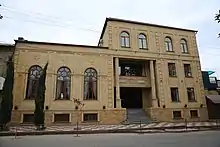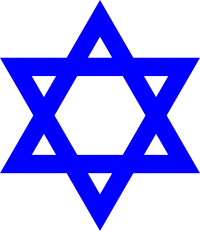Derbent Synagogue
The Derbent Synagogue, it's also known as Kele-Numaz (Russian: Дербентская синагога "Келе-Нумаз"; Hebrew: בית הכנסת דרבנט "קל-נומז") is the only synagogue in the city of Derbent, located on 94 Tagi-Zade Street. Center for the spiritual life of the Jews of Derbent.
| Derbent Synagogue Дербентская синагога | |
|---|---|
 | |
| Religion | |
| Affiliation | Orthodox Judaism |
| Status | Active |
| Location | |
| Location | 94 Tagi-Zade Street |
| Municipality | Derbent |
| State | Dagestan |
| Country | |
| Geographic coordinates | 42°03′25″N 48°17′29″E |
| Architecture | |
| Type | Synagogue |
| Funded by | The Khanukaev Family |
| Completed | 1914 |
| Materials | Limestone blocks |
History
People of Derbent in the 19th century were settled according to the following principle: the upper, oldest part of the city, closer to the citadel of Naryn-Kala, is Muslims; in the central, flat part - mainly Mountain Jews lived, and lower, closer to the sea – Armenians and Russians. The main street that lived Mountain Jewish, Tagi-Zade was called "Kele-Kuche" which means "Big (long) street", and its other name is "Juhuro mahallah" (Jewish quarter). On this street stands the Derbent Synagogue - "Kele-Numaz".[1]
The synagogue "Kele-Numaz" was built by established merchants, the Khanukaev family. The architect of the building is unknown. The synagogue was opened in 1914. However, over the past hundred years, the building has become very outdated. Currently, the synagogue is under the supervision of the Federation of Jewish Communities of Russia (FJCR).
By the time of the establishment of Soviet power, there were 11 Jewish synagogues in the city, including: the "Kele-Numaz" synagogue, the “Ashkenazi” synagogue of European Jews, prayer houses - "Khivro", "Hanukhi", "Ogyo", "Milhochi", named by the names of their owners or by the names of those villages where their founders came from - “Orogi” (Upper Arag), “Mugorti” (Mugarty) and “Pendzhi” (Heli-Pendzhinsky).
In November 1903, the head of the civilian affairs in the Caucasus, in response to the request of the Mountain Jews, ordered the city to build a chapel for the Jews, but with a condition that it should not be called either a synagogue, or a prayer house or a school.
In February 1904, the Mountain Jewish community petitioned the city authorities with a request to allocate land for the construction of a new synagogue. The petition said that during the time of the Derbent Khanate, the Jews built a synagogue for themselves on the 2nd Komendantskaya Street (meaning the "Midrash Eliyahu" synagogue), but over time number of congregants have increased, the synagogue cannot accommodate worshipers, and therefore they need a bigger synagogue.
However, the city authorities, guided by the above order of the chief in the Caucasus, who forbade the construction of a synagogue in the city, allocated a piece of land of 300 square meters to the Mountain Jewish community for the construction of a prayer house at the corner of Golitsyn Street (now Buynaksk Street) and Kolodezny Lane (now Chapayev Lane).
Restoration
In 2000, the "Kele-Numaz" synagogue was in disrepair. In 2009, congregants decided to make its reconstruction.
The synagogue building was dismantled and reconstructed using old stones and new materials. The transformed building became known as the "Jewish Community Center". This process took exactly 9 months.
Above the main entrance of the Jewish community center written in Hebrew, which reads: And let them make me a sanctuary, that I may dwell in their midst.
The total area of the Jewish Community Center is 2500 square meters. There is the office of the rabbis, male and female mikveh, the Municipal Kindergarten and the Museum of Mountain Jews.
The synagogue was opened in a solemn ceremony on March 22, 2010, with the presence of the President of Dagestan Magomedsalam Magomedov and Chief Rabbi of Russia Berel Lazar.[2]
References
External links
- Synagogue "Kele-Numaz", Derbent
- Jewish community of ancient Derbent
- Opening of the synagogue in Derbent, March 22, 2010
- Bringing the Sefer Torah to the Synagogue of Derbent
| Wikimedia Commons has media related to Derbent Synagogue. |

